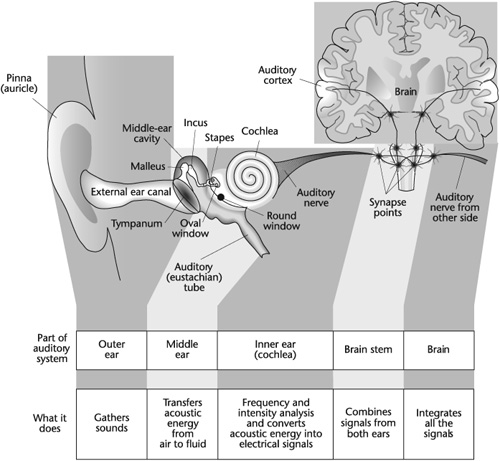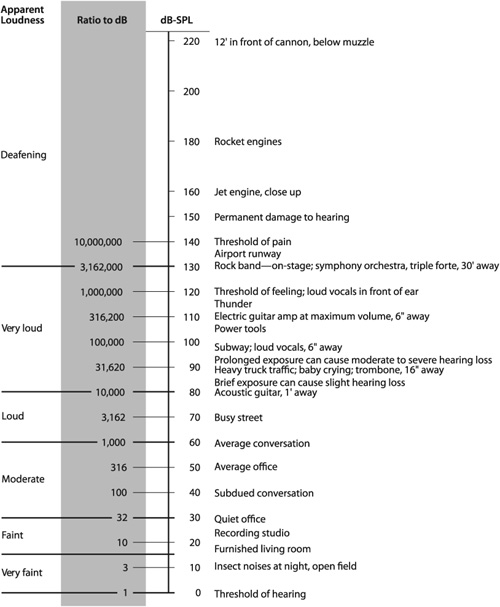To work in sound, aural acuity is all-important. Therefore, before beginning any discussion of the basics of audio, it is essential to understand the ear and hearing. It may belabor the obvious, but if your hearing is impaired, a career in audio production becomes moot. Because we are a nation of the hard-of-hearing, emphasizing the obvious reinforces the importance of ear care and protection against loud sound.
The human auditory system is one of the body’s most complex and delicate systems. In general, when it functions normally, it transforms sound waves into a series of electrical impulses. When these impulses reach the auditory center of the brain, they can be identified as sound. The entire process occurs within a split second.
The human ear is divided into three parts: the outer ear, the middle ear, and the inner ear (see Figure 2-1). Sound waves first reach and are collected by the pinna (or auricle), the visible part of the outer ear. The sound waves are then focused through the ear canal, or meatus, to the eardrum (tympanum) at the beginning of the middle ear.
The tympanic membrane is attached to another membrane, called the oval window, by three small bones—the malleus, incus, and stapes—called ossicles and shaped like a hammer, anvil, and stirrup, respectively. The ossicles act as a mechanical lever, changing the small pressure of the sound wave on the eardrum, thereby amplifying the sound vibrations before transmitting them to the inner ear. The combined action of the ossicles and the area of the tympanum allow the middle ear to protect the inner ear from pressure changes (loud sounds) that are too great. It takes about one-tenth of a second to react, however, and therefore provides little protection from sudden loud sounds.
The inner ear contains the semicircular canals, which are necessary for balance, and a snail-shaped structure called the cochlea. The cochlea is within an area smaller than the diameter of a dime and is filled with a fluid whose total capacity is a fraction of a drop. It is here that sound becomes electricity in the human head. Running through the center of the cochlea is the basilar membrane, resting on sensory hair cells attached to nerve fibers composing the organ of Corti, the “seat of hearing.” These fibers feed the auditory nerve, where the electrical impulses are passed on to the brain. It is estimated that as many as 16,000 sensory hair cells are present at birth. In the upper portion of each cell is a bundle of microscopic hairlike projections called stereocilia, or cilia for short, which quiver at the approach of sound and begin the process of transforming mechanical vibrations into electrical and chemical signals, which are then sent to the brain. In a symmetrical layout, these sensory hair cells are referred to as “outer” and “inner” sensory hair cells (see Figure 2-2). Approximately 12,000 outer hair cells amplify auditory signals and discriminate frequency. About 140 cilia jut from each cell. The 4,000 inner hair cells are connected to the auditory nerve fibers leading to the brain. About 40 cilia are attached to each inner cell (see Figure 2-3a). Continued exposure to high sound-pressure levels can damage the sensory hair cells, and because they are not naturally repaired or replaced, hearing loss results. The greater the number of damaged hair cells, the greater the loss of hearing (see Figure 2-3b).

Figure 2-2. Artistic representation of the organ of Corti, showing the symmetrical layout of the outer and inner sensory hair cells.

Figure 2-3. Scanning electron micrographs of healthy and damaged stereocilia. (a) In the normal cochlea, the stereocilia of a single row of inner hair cells (top) and three rows of outer hair cells (bottom) are present in an orderly array. (b) In the damaged cochlea, there is disruption of the inner hair cells and loss of the outer hair cells. This damage produced a profound hearing loss after exposure to 90 dBA noise for eight hours six months earlier. Although these micrographs are of the organ of Corti of a lab rat, they serve to demonstrate the severe effects of overexposure to loud sound. (The “A” in the dB value refers to the filter used for measuring frequency response that bears a close resemblance to the response of the human ear.)
Every day, the noise around us becomes ever louder—noise from traffic, airplanes, lawn mowers, sirens, vacuum cleaners, hair dryers, air conditioners, blenders, waste disposals, can openers, snow mobiles, and even children’s toys. In modern homes with wood floors, cathedral ceilings, brick or stucco walls, and many windows, sound is reflected and therefore intensified because there is little to absorb it. It is becoming increasingly rare to find a quiet neighborhood.
Parks and campgrounds are inundated with the annoying sounds of RVs, boisterous families, and blaring boom boxes. At beaches, the lap and wash of gentle surf is drowned out by the roar of motorboats and jet skis. Cell phones, MP3 players, and iPods with their ear-mounted headphones or earbuds present an increasing threat to young people, who are showing signs of hearing loss more typical of older adults. At rock concerts, parties, and bars, sound levels are so loud it is necessary to shout to be heard, increasing the din and raising the noise floor even more. More people suffer from hearing loss than from heart disease, cancer, multiple sclerosis, and kidney disease combined. Noise-induced hearing loss affects about one out of every eight children in the United States. Because it is usually not life-threatening, hearing loss is possibly United States’s most overlooked physical ailment.
In industrialized societies, some hearing loss is a natural result of aging, but it is not an inevitable consequence. In cultures less technologically advanced than ours, people in their eighties have relatively normal hearing. Short of relocating to such a society, for now the only defense against hearing loss is prevention.
Usually, when hearing loss occurs it does so gradually, typically without warning signs, and it occurs over a lifetime. When there are warning signs, they usually are due to overstimulation from continuous, prolonged exposure to loud sound. You can tell there has been damage when there is ear discomfort after exposure; it is difficult to hear in noisy surroundings; it is difficult to understand a child’s speech or an adult’s speech at more than a few feet away; music loses its color; quiet sounds are muffled or inaudible; it is necessary to keep raising the volume on the radio or TV; and your response to a question is usually, “What?” The main problem for most people with hearing loss is not the need for an increase in the level of sound but in the clarity of sound.
Two common forms of hearing loss are conductive hearing loss and sensorineural hearing loss.
Conductive hearing loss occurs when the eardrum or middle ear is damaged from disease; infection; excessive ear wax; foreign objects that block the eardrum; trauma to the head or neck; systemic disorders, such as high or low blood pressure, vascular disorders, and thyroid dysfunction; and high doses of certain medications such as sedatives, antidepressants, and anti-inflammatory drugs.
Sensorineural hearing loss is nerve-based. It occurs when the microscopic hair cells of the inner ear are compromised or damaged. Once damaged, whatever the degree of hearing loss is permanent and irreversible. Among the causes of sensorineural hearing loss are aging, a genetic disorder, disease, high fever, or overexposure to loud sound, which is the concern here.
Hearing damage caused by exposure to loud sound varies with the exposure time and the individual. Prolonged exposure to loud sound decreases the ear’s sensitivity. Decreased sensitivity creates the false perception that sound is not as loud as it actually is. This usually necessitates an increase in levels to compensate for the hearing loss, thus making a bad situation worse.
After exposure to loud sound for a few hours, you may have experienced the sensation that your ears were stuffed with cotton. This is known as temporary threshold shift (TTS)—a reversible desensitization in hearing that disappears in anywhere from a few hours to several days; TTS is also called auditory fatigue. With TTS the ears have, in effect, shut down to protect themselves against very loud sounds. Sometimes intermittent hearing loss can occur in the higher frequencies unrelated to exposure to loud sound. In such instances elevated levels in cholesterol and triglycerides may be the cause. A blood test can determine if this is the case.
Prolonged exposure to loud sounds can bring on tinnitus—a ringing, whistling, or buzzing in the ears—even though there is no acoustic stimulus. Although researchers do not know all the specific mechanisms that cause tinnitus, one condition that creates its onset, without question, is inner-ear nerve damage from overexposure to loud noise levels. Tinnitus is a danger signal that the ears may already have suffered—or soon will—permanent threshold shift with continued exposure to loud sound.
Being aware of sound pressure level is key to understanding the dangers of exposure to loud sound. Acoustic sound pressure is measured in terms of sound-pressure level (dB-SPL) because there are periodic variations in atmospheric pressure in a sound wave. Humans have the potential to hear an extremely wide range of these periodic variations, from 0 dB-SPL, the threshold of hearing; to 120 dB-SPL, what acousticians call the threshold of feeling; to 140 dB-SPL, the threshold of pain, and beyond. Figure 2-4 shows the relative loudness of various sounds, many that are common in our everyday lives. The range of the difference in decibels between the loudest and the quietest sound a vibrating object makes is called dynamic range. Because this range is so wide, a logarithmic scale is used to compress loudness measurement into more manageable figures. (On a linear scale, a unit of 1 adds an increment of 1. On a logarithmic scale, a unit of 1 multiplies by a factor of 10.)
Humans have the capability to hear loudness at a ratio of 1:10,000,000 and greater. A sound-pressure-level change of 1 dB increases amplitude 12 percent; an increase of 6 dB-SPL doubles amplitude; 20 dB increases amplitude 10 times. Sound at 60 dB-SPL is 1,000 times louder than sound at 0 dB-SPL; at 80 dB-SPL, it is 10 times louder than at 60 dB-SPL. If the amplitude of two similar sounds is 100 dB-SPL each, their amplitude, when added, would be 103 dB-SPL. Nevertheless, most people do not perceive a sound level as doubled until it has increased anywhere from 3 to 10 dB, depending on their aural acuity. There are other acoustic measurements of human hearing based on the interactive relationship between frequency and amplitude (see Chapter 3).
As gradual deterioration of the auditory nerve endings occurs with aging, it usually results in a gradual loss of hearing first in the mid-high-frequency range—at around 3,000 to 6,000 Hz—then in the lower-pitched sounds. The ability to hear in the mid-high-frequency range is important to understanding speech because consonants are mostly composed of high frequencies. Hearing loss in the lower-pitched sounds makes it difficult to understand vowels and lower-pitched voices. Prolonged exposure to loud sounds hastens this deterioration. To avoid premature hearing loss, the remedy is simple: Do not expose your ears to excessively loud sound levels for extended periods of time (see Figures 2-5, 2-6, and 2-7)
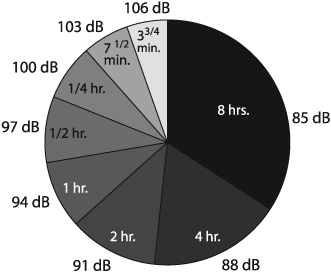
Figure 2-5. The National Institute for Occupational Safety and Health (NIOSH) recommended sound-pressure-level (SPL) exposure guidelines. These guidelines are based on maximum daily safe exposure amounts measured as time-weighted averages (TWAs) over a 40-year period.
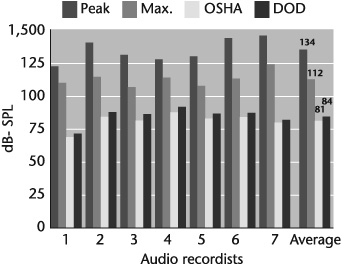
Figure 2-6. Peak, average maximum, and calculated average sound-pressure-level exposures by Occupational Safety and Health Administration (OSHA) and Department of Defense (DOD) standards. These results are in relation to the daily exposure to loudness of seven different audio recordists. It is estimated that recordists work an average of 8 to 10 hours per day.
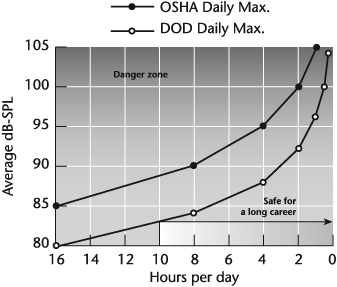
Figure 2-7. Allowable daily exposure of sound-pressure levels plotted in relation to OSHA and DOD-permissible exposure levels.
Hearing impairment is not the only detrimental consequence of loud sound levels. They also produce adverse physiological effects. Sounds transmitted to the brain follow two paths. One path carries sound to the auditory center, where it is perceived and interpreted. The other goes to the brain centers that affect the nervous system. Loud sound taking the latter path can increase heart rate and blood pressure, constrict small blood vessels in the hands and the feet, contract muscles, release stress-related hormones from adrenal glands, disrupt certain stomach and intestinal functions, and create dry mouth, dilated pupils, tension, anxiety, fatigue, and irritability.
When in the presence of loud sound during audio production, including listening to music, wear earplugs designed to reduce loudness without seriously degrading frequency response. Some options among available earplugs are custom-fit earmolds, disposable foam plugs, reusable silicon insert plugs, and industrial headsets. The custom-fit ear-mold is best to use because, as the term suggests, it is made from a custom mold of your ear canal. It is comfortable and does not give you the stopped-up feeling of foam plugs. It provides balanced sound-level reduction and attenuates all frequencies evenly.
Some custom earplugs can be made with interchangeable inserts that attenuate loudness at different decibel levels. The disposable foam plug is intended for one-time use; it provides noise reduction from 12 to 30 dB, mainly in the high frequencies. The reusable silicon insert plug is a rubberized cushion that covers a tiny metal filtering diaphragm; it reduces sound levels by approximately 17 dB. The silicon insert plug is often used at construction sites and firing ranges. The industrial headset has a cushioned headpad and tight-fitting earseals; it provides maximum sound-level attenuation, often up to 30 dB, and is particularly effective at low frequencies. This is the headset commonly used by personnel around airport runways and in the cabs of heavy-construction equipment (see Figure 2-8).
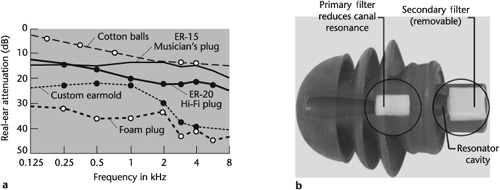
Figure 2-8. Attenuation effects of selected hearing-protection devices. (a) Notice that compared with a variety of commonly used hearing protectors, the Musician’s and Hi-Fi plugs have relatively even attenuation across the frequency spectrum. (The ER-15 and the ER-20 are products of Etymotic Research, which makes a variety of hearing protectors for musicians and hi-fi listeners that attenuate loudness from 9 to 25 dB. (b) The HearPlugz-DF by E.A.R. Inc. provides dual filtering with noise reduction ratings of 12 to 22 dB.)
As a general guideline, hearing protectors are recommended at levels from 87 or 88 db-SPL to 89 dB-SPL; they are necessary from 90 to 97 dB-SPL; and, from 100 dB-SPL and higher, they should be worn with extra care.
The human ear is a very sophisticated electromechanical device. As with any device, regular maintenance is wise, especially for the audio professional. Make at least two visits per year to a qualified ear, nose, and throat (ENT) specialist to have your ears inspected and cleaned. The human ear secretes wax to protect the eardrum and the cochlea from loud sound-pressure levels. Let the doctor clean out the wax. Do not use a cotton swab. You risk the chance of infection and jamming the wax against the eardrum, which obviously exacerbates the situation. If you must clean your ears between visits, ask the ENT doctor about the safest way to do it.
Other safeguards include working with listening levels as low as possible, taking regular breaks in a quiet environment during production sessions, and having an audiologist test your hearing at least once a year. Be aware that most standard hearing tests measure octave bands in only the 125 to 8,000 Hz hearing range, essentially the speech range. There are hearing tests with much wider ranges that are more appropriate for the audio professional.
The implications of all this should be obvious, especially if you are working in audio: not only is your hearing in particular and your physiological well-being in general at risk, but so is your livelihood.
The human auditory system is one of the body’s most complex and delicate systems.
The human ear is divided into three parts: the outer ear, the middle ear, and the inner ear.
In the basilar membrane of the inner ear, bundles of microscopic hairlike projections called cilia are attached to each sensory hair cell. They quiver at the approach of sound and begin the process of transforming mechanical vibrations into electrical and chemical signals, which are then sent to the brain.
Conductive hearing loss occurs when the eardrum or middle ear is damaged from disease; infection; excessive ear wax; foreign objects that block the eardrum; trauma to the head or neck; systemic disorders such as high or low blood pressure, vascular disorders, and thyroid dysfunction; and high doses of certain medications such as sedatives, antidepressants, and anti-inflammatory drugs.
Sensorineural hearing loss is nerve-based. It occurs when the microscopic hair cells of the inner ear are compromised or damaged. The cause of sensorineural hearing loss of concern in audio is overexposure to loud sound.
Temporary threshold shift (TTS), or auditory fatigue, is a reversible desensitization in hearing caused by exposure to loud sound over a few hours.
Prolonged exposure to loud sound can bring on tinnitus—a ringing, whistling, or buzzing in the ears—even though there is no acoustic stimulus.
Exposure to loud sound for extended periods of time can cause permanent threshold shift—a deterioration of the auditory nerve endings in the inner ear.
Acoustic sound pressure is measured in terms of sound-pressure level (dB-SPL) because there are periodic variations in atmospheric pressure in a sound wave.
Humans can hear from 0 dB-SPL, the threshold of hearing; to 120 dB-SPL, the threshold of feeling; to 140 dB-SPL, the threshold of pain and beyond. The scale is logarithmic, which means that adding two sounds each with a loudness of 100 dB-SPL would bring it to 103 dB-SPL. The range of difference in decibels between the loudest and the quietest sound a vibrating object makes is called dynamic range.
In the presence of loud sound during audio production, including listening to music, use an ear filter (hearing protection device) designed to reduce loudness without seriously degrading frequency response.

